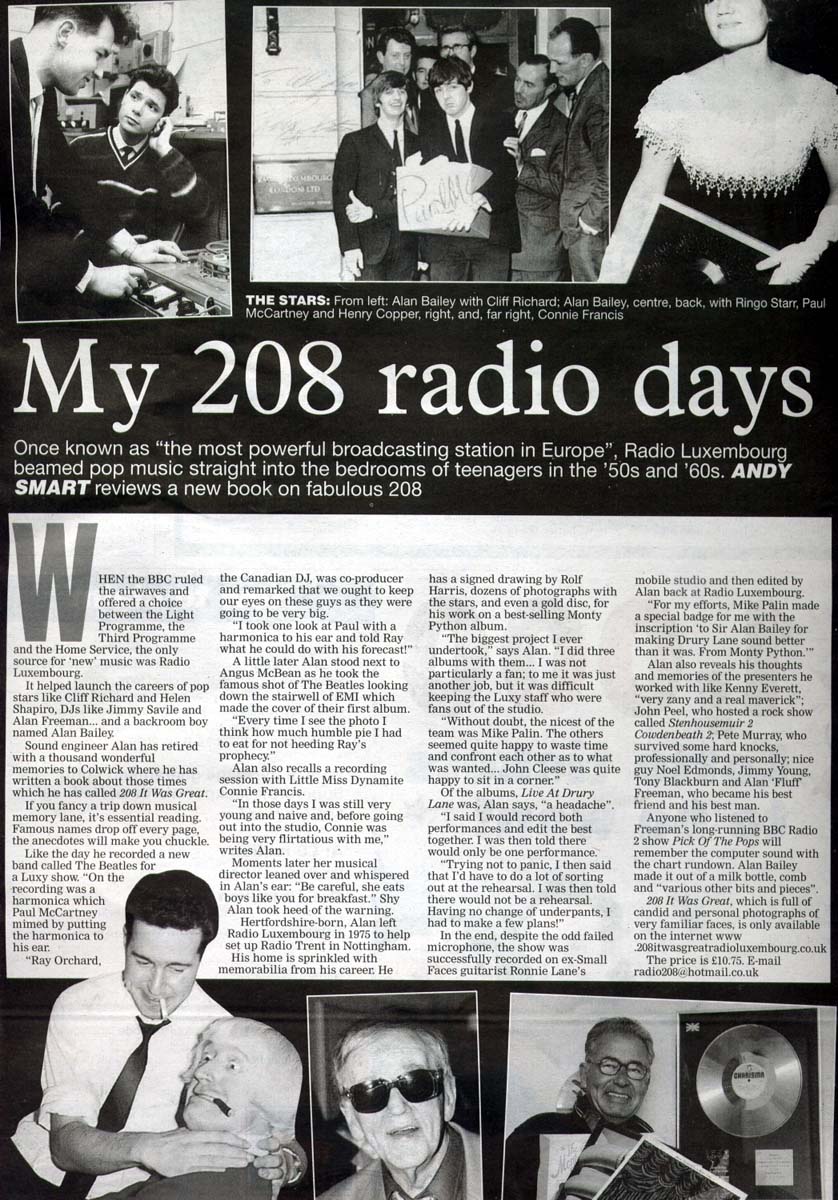From a future publication.
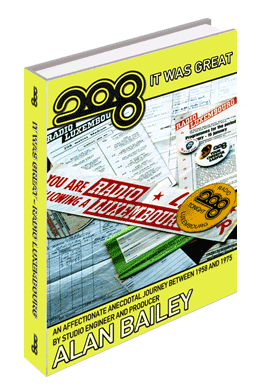 The first programme I gram operated for was 'Italy Sings' with Keith Fordyce, a quarter hour programme sponsored by
the Italian State Tourist Office. Keith, at this time, was appearing on TV regularly in pop orientated shows such
as 'Ready Steady Go' and made his first radio broadcast for B.F.N. (British Forces Network), Hamburg in 1948 whilst
serving in the R.A.F. The format for ' Italy Sings' was to play records with an Italian bias such as 'Volare' or
'Return to Me' by Dean Martin and 'Come Prima' by Marino Marini. 'Line Engaged' was another programme we worked on
regularly, sponsored by Brooke Bond. The producer was John Hanson and the format was for engaged couples to relate
unusual stories about how they became engaged. Winning letters would receive a 21 piece bone china tea set. I also
became the proud owner of one of these sets which really was not allowed. That was a bit naughty but nice.
Another programme I worked on regularly with Keith was the 'Philips Record Show' and the theme tune was 'Believe it
beloved' by Johnny Gregory. Dave Gell also had a Philips record show I was involved with and his theme was 'La Grisb
i.'
The first programme I gram operated for was 'Italy Sings' with Keith Fordyce, a quarter hour programme sponsored by
the Italian State Tourist Office. Keith, at this time, was appearing on TV regularly in pop orientated shows such
as 'Ready Steady Go' and made his first radio broadcast for B.F.N. (British Forces Network), Hamburg in 1948 whilst
serving in the R.A.F. The format for ' Italy Sings' was to play records with an Italian bias such as 'Volare' or
'Return to Me' by Dean Martin and 'Come Prima' by Marino Marini. 'Line Engaged' was another programme we worked on
regularly, sponsored by Brooke Bond. The producer was John Hanson and the format was for engaged couples to relate
unusual stories about how they became engaged. Winning letters would receive a 21 piece bone china tea set. I also
became the proud owner of one of these sets which really was not allowed. That was a bit naughty but nice.
Another programme I worked on regularly with Keith was the 'Philips Record Show' and the theme tune was 'Believe it
beloved' by Johnny Gregory. Dave Gell also had a Philips record show I was involved with and his theme was 'La Grisb
i.' As I became more adept, I was allowed to gram operate on shows which included well-known artists for daily request shows starting with 'Monday's requests' through to 'Friday's requests,' and these were hosted by Beryl Reid, George Elrick, Richard Murdoch, Libby Morris and Teddy Johnson. Although they were called record request programmes , they weren't really. Some of the records would be requests, whilst other music tracks would be dedications because we recorded a lot of music either in the studio or on location live by such artists as the Big Ben Banjo Band, the Joe Loss Orchestra, The Ted Heath Orchestra and Ken Mackintosh, which were intermingled with the records. The signature tune for these programmes was 'The Luxembourg Waltz' by Frank Chacksfield. The Deep River Boys, featuring Harry Douglas and Al Bishop, were a black gospel group from the USA.They used to come over once a year and record several series which would last until their return the following year. They were recorded in Studio A with the Bernie Fenton quartet and the Big Band Sessions were done on location at various town halls like Lewisham, Hammersmith or Poplar Civic Theatre. The big bands had their own singers and they covered some of the big pop hits of the day for the broadcast. People like Joan Small, Lita Roza, Kenny Bardell, Rose Brennan, Tony Brent, Dennis Lotis and Dickie Valentine all lent their vocal talents. Ross McManus was a singer with Joe Loss and became known as the 'R White's secret lemonade drinker' in the TV advert. His son went on to make a big name for himself as Elvis Costello and is currently married to that wonderful jazz singer Diana Krall. Edmundo Ros and his Latin American orchestra were recorded in Studio A. Eric Winstone hosted a children's programme early on Sunday evening. It was called 'Butlin Beavers' and was sponsored by Butlins' the well known holiday camp people.Not all programmes were sponsored; these were known as sustained programmes. Most were made up of special 16 inch transcription discs. If you are of the age to remember vinyl 12 inch long playing records, it will give you an idea of the size of these monsters! Sometimes the grooves would start from the outside edge like a conventional vinyl disc and sometimes they were inside start. Some of the grooves went side to side like a conventional disc, called 'lateral cut' and some went up and down, commonly known as Hill and Dale or 'vertical cut.' This information was always printed on the label. The turntable speed was 33? rpm and if there was more than one part, the sides would be numbered thus, 1 & 3, 2 & 4, etc. This was in order that you could play a very long programme from disc continuously without commercial breaks using two turntables. In most cases, they were drama or comedy shows like 'Box 13' with Alan Ladd, 'Bold Venture' with Humphrey Bogart and Lauren Bacall, Fabian of the Yard,' 'The Bob Hope Show' and 'The Scarlet Pimpernel.' Some were musical shows like, 'Riverboat Shuffle,' 'Liberace Show,' 'The Stanley Holloway Show' and the 'Vera Lynn Show.'
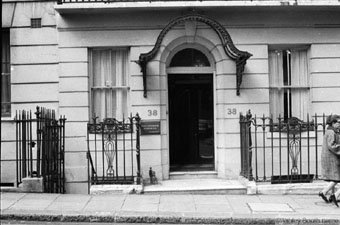
Radio Luxembourg's London Studio's
38 Hertford Street W1, London
D-E-C-C-A., the familiar fanfare for the Decca Record shows, was composed by Eric Rogers and Oscar. Eric Rogers was a well-known musical arranger and conductor, and Oscar was the pseudonym for Decca headman, Mr. S. A. Beecher-Stevens, in order to claim performance fees whenever it was played. It was Jack Jackson's vocal talents on the fanfare, which said either, "oooohhh, it's Saturday!", or "oooohhh, it's Monday!" and the band members were basically session men mainly from the Ted Heath band. He was a very funny, happy man and I enjoyed working with him very much. Jack never worked from a script which made it difficult to spin records in and he never gave a straight cue for the record. For example, he would back announce a record and then say, "Hello - we've been deserted" and I would spin in the record, 'Everyone's gone to the moon' by Jonathan King, cutting off the introduction and starting the record on the vocal. This involved me keeping one eye on Jack waiting for a nod and one eye on the turntable, as we had to turn the record back a quarter of a turn so that, when it started, it would pick up to the right speed, which meant in most cases, working on instinct as to what Jack was going to say.
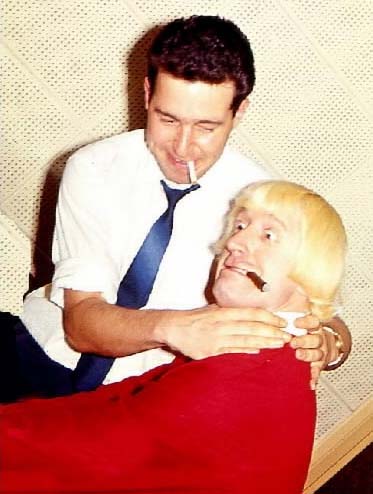
Jimmy Savile was also a professional
wrestler and here with Alan Bailey
he practises a few grunts and
groans
in Studio B.
In 1960 Jimmy went to the United States to present Elvis Presley with a Gold Disc for "It's Now or Never" on the set of Paramount Studios where Elvis was filming. Jimmy remembers vividly Colonel Tom Parker ushering him through the set with great authority saying "So you wanna see my boy eh? - Stay close." When Jimmy presented Elvis with the gold disc, Elvis repaid the compliment by presenting Jimmy with a Stetson type cowboy hat. A few weeks after Jimmy's return, he gave the hat to me and it still holds pride of place today.
EMI had many more DJs than Decca. This was probably partly due to a lot of EMI shows being quarter hour slots. I could never understand the criteria for selecting DJ's at EMI. They seemed to use people who had no link whatsoever with the pop music business. People like Peter West, Richard Lyon, Freddie Mills, Valerie Singleton and Shaw Taylor. To me, they were unlikely to attract the teenagers who would buy the latest singles. However to me, Kenny Lynch, Carol Deene, Ronnie Hilton, Jimmy Young, Steve Race and Sam Costa were OK because they, at least, were in the music business. Ray Orchard, the Canadian DJ, was the producer of the EMI shows, although in later years Ken Evans took over the mantle.

Sam Costa in Studio A for his EMI shows
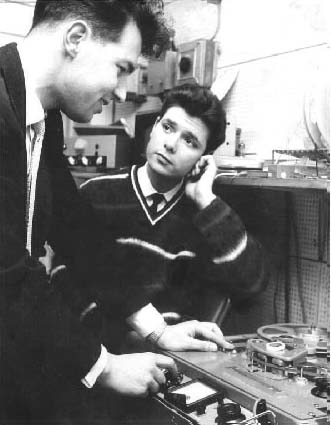
Alan Baily and Cliff Richard listen
back to a music track just
recorded in Studio A in 1962.
Leonard Reginald Smith was born in Greenwich, London on 15th of April 1939 and became the legendary Marty Wilde and amongst many things Cliff and Marty Wilde had in common is that at different times, they both had the same two musicians in their group. They were Liquorice Locking and Brian Bennett and my first 'outing' with Marty Wilde and his Wildcats was at Lewisham Town Hall for an outside broadcast. His group at that time consisted of Liquorice Locking and Big Jim Sullivan on guitars with Brian Bennett on drums. We all met up again a few weeks later in Studio A at Hertford Street to record a series with Marty. Apart from his hits, we did an interesting little number that his fans certainly wouldn't know. It was called, "The curse of the Black Spot." We needed another music track to complete the series so the boys went into the studio and ad-libbed an instrumental piece with a musical break in the verses in which Marty, in his best Long John Silver voice, inserted, "Ah, 'tis the curse of the black spot." Most people still hear Brian Bennett almost daily without realising it because he writes and performs music for radio and television commercials.
With all the British artists having massive hits like Cliff and Marty, it was just a question of time before Billy Fury graced Studio A with his presence, which was just after, 'Halfway to Paradise' charted. Billy was born in Liverpool on April the 17th 1940 and christened Ronald William Wycherley. Larry Parnes his manager changed Ronalds' name to Billy Fury, Billy after Billy Cotton the band leader and Fury because he was very shy and wanted to signify strength. Billy was booked for a thirteen week series on Luxy provisionally titled, 'Billy's Pad. Clem Cattini was on drums, Heinz Burt and Colin Green on guitars. The musical director was Reg 'Earl' Guest on piano. Some of the numbers I remember were 'Am I blue?' the jazz classic 'Like young,' 'Slow boat to China,' and 'Wheels.' On the last day of recording we went to the pub opposite at lunchtime and dear old Bill had a drop too much and just couldn't stop laughing. Luckily, we had everything in the can and when we got back to the studio to clear up, Bill insisted on giving us one more tune. We set the recorder running and he gave us his unique version of, 'When Lulu was bathing the baby.' We were all rolling about with laughter, an image which remains to this day. I don't think his road manager, Hal Carter, was too pleased, he was always push, push, but then that was his job.
My first meeting with the Beatles was with an audience participation show at EMI's head office in their conference
room at 20 Manchester Square in London just behind Oxford Street. The show was called, 'The Monday Spectacular,
' later called 'The Friday Spectacular,' due to re-scheduling. The format of the show was to present EMI's new
records to the listeners at home and, for the studio audience at the recording, the artists would mime to their
latest record after giving an interview. On this occasion, the Beatles were wearing shiny brown suits with
black collars. They had their typical hair-do of the day, 'The Pudding Basin.' On the recording was a
harmonica which Paul McCartney mimed to by putting a harmonica to his ear. Ray Orchard, the Canadian DJ,
was co-producer and remarked that we ought to keep our eyes on these guys as they were going to be very big.
I took one look at Paul with a harmonica to his ear and told Ray what he could do with his forecast!
The second Beatles meeting came about a year later in the confines of studio A. We ran a series called,
'Battle of the Giants' sponsored by National Benzole and presented by Canadian DJ, Doug Stanley. The format
was for top groups to compete over the weeks leading up to a semi-final, then the final. The top group
would be voted for by the listeners and a trophy awarded. Such groups were, The Searchers, Beach Boys,
Swinging Blue Jeans, The Hollies, The Stones and The Beatles. The Beatles won and in keeping with the
programme title, Henry Cooper the world famous boxer presented the Trophy.
'The Friday Spectacular' was not the only outside broadcast we did at EMI house in Manchester Square. There was
'Record Roulette' and 'Dancing Party.' 'Record Roulette' was quite difficult to do in that I had to select the
discs at lightning speed at a moments notice and cue them ready to play. The idea of the show is in the title
really. There was a giant roulette wheel in the auditorium before a teenage audience. There were twenty four
numbers on the wheel and these numbers matched a giant board with twenty four record titles on it. Members of
the audience would then give the wheel a spin and, whichever number the ball settled on, that record would be
played virtually instantly and, on certain numbers, there would be a prize for the contestant, usually a travel
bag or EMI record vouchers. The show was hosted by David Jacobs, Maggie Stredder (ex Vernon Girl) and Russell
Turner. Head honcho of EMI Records, Arthur Muxlow, was the producer out on the floor and Ray Orchard was co
producer with us in the control room. 'Dancing Party' was a strange animal indeed in that the programme gave
dancing lessons ….. on radio! It was another audience participation record show but in the middle of it Marie
Cartmell, a professional dancing instructor, gave out instructions for foot and body movements to the latest
dance craze. In those days it would be 'The Madison,' 'The Twist' and the like. As she gave out instructions,
fellow presenters of the show Muriel Young, Alan Dell, Joe Loss and Ray Orchard demonstrated the moves to the
audience present which at times could be quite hilarious. EMI produced instruction sheets for the listening
audience which were provided in record shops or by applying to EMI.
Our record library was quite comprehensive in the days of 78 rpm shellac discs but, inevitably, because of storage space, we occasionally had a purge which came in very handy for programmes like 'Smash Hits' hosted by Bob Monkhouse and Dennis Goodwin. The programme originated out in Luxembourg when it went out live with hosts Keith Fordyce and Aussie Barry Alldis. The programme format was for listeners to write in stating the record they hated the most. Bob and Dennis would play it one last time then theoretically 'smash' it. They didn't really - the records we had purged were brought down to the studio and we recorded lots of these being smashed. We would throw them up in the air to smash on the floor, let the piano lid fall on them; throw them at the wall, just to get lots of effects to use on the programme. With the advent of 45's and LP's, it unfortunately saw the end of the programme which also coincided with Dennis Goodwin going off to the States to write for comedian Bob Hope.
Teddy Johnson always seemed to be around. He was a great friend of boss man Geoffrey Everitt. Geoff during the war was an instructor in Royal Engineers at the School of Chemical Warfare. After the war he was posted to Luxembourg to help reorganise the army of Luxembourg. While he was there he was invited to host a programme on Radio Luxembourg about football, and being a staunch supporter of Arsenal FC readily agreed. Soon after he was offered regular employment following his demob.
On a chance meeting, Teddy Johnson was also offered employment
and went to work with Geoff. They worked together as DJs out in Luxembourg when the station was building in
popularity. In later years Teddy was also compering a weeknight programme and a live music programme with his
wife Pearl Carr. Sometimes our studio duties would take in recording demos of unknown people. I remember
recording a group led by Paul Gadd on quite a few occasions. Later, he changed his name to Paul Raven but
it really didn't mean anything to me until 1975 when I moved to another radio station and he visited the
station under his stage name, Gary Glitter, pointed to me and said, "You used to do all my demos."
We were recording the Ted Heath Big Band on regular occasions as outside broadcasts without an audience, and
what a wonderful team of musicians they were! The one thing I had a job coming to terms with on the Ted
Heath sessions was, on playback of the recorded tracks, how Ted would put his ear right up against the
loudspeaker to hear our recording which was blasting out, because of his deafness. The volume really hurt
us but Ted found it comfortable.

Norrie Paramor (left) and
Harold Berens on an outside
broadcast (OB) with the
"Big Ben Banjo Band".
Playing
Peek a Boo
Bert Weedon on banjo.
It is rumoured that when the Germans occupied Luxembourg local people got a lot of the valuable recordings and buried them in the Parc municipal to protect them from being destroyed. If it is true, nobody's uncovered them yet.
In later years, when most of the programmes came live from Luxy, they had a team of young DJs that I rarely met. It was just as well because the work we were doing in the studio had escalated into other areas hitherto unexplored. The team at that time was Dave 'Kid' Jensen, Tony Prince, Mark Wesley, Noel Edmonds, Paul Burnett, Dave Christian, Peter Powell and Bob Stewart.
Mark Wesley was born on the 24 th of January 1948 in Southend on Sea, Essex and came to Luxy after being known as Mark West on Radio Scotland. He had to change his name at another radio station because they already had a Mark West. He stayed with Luxy for 9 years. Today he runs his own jingle company supplying musical adverts to local radio stations. He has always been musically minded. I recorded a series of Luxy jingles with him at Hertford Street.
Dave Christian was born in Weymouth, Dorset on the 31st of August 1949 and christened David Crockford. He's a guy with a fantastic deep voice and, being multi-lingual, was often used by the other services on Luxembourg (Radio-Tele-Luxembourg). Dave was another 'lucky breaker' in that he used to help Aussie Tony Windsor from pirate ship Radio London at various venues and, when Tony came to Luxy, Dave came to see him on an unrelated matter and was offered a position out in Luxembourg.
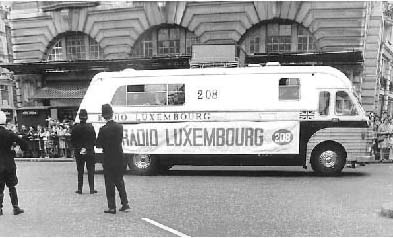
The 208 bus passes Piccadilly Circus
during "The Festival of London".
The biggest project I ever undertook was for the Charisma label, Monty Python. I did three albums with them, 'Monty Python's previous album,' 'Matching tie and handkerchief,' and 'Live at Drury Lane.' I was not particularly a fan of theirs but I had seen their TV shows and, to me, it was just another job but it was difficult keeping Luxy staff out of the studio that were fans and would make any excuse to violate the red light. I did realise how big the group were and how much bigger they would be, so I decided I would immortalise myself by voicing some of the sound effects. I used by own body for the massage effects between sketches. I was the chemist who yelled when invaded by a herd of zebras, a sneezing ant, various farts and a falling prince in the fairy story. It is an amazing feeling knowing that, throughout the world, nobody knows my name or anything about me, yet millions have heard me. I had similar feelings when I first joined Luxy and thought millions of people are hearing my work. On the inner sleeve limited edition, I received no less than eight mentions and also got Kid Jensen and Paul Burnett a few name mentions. On the album, 'Matching tie and handkerchief,' I didn't do as much work. One thing I am pleased about is the special process we did on that album. During the Warner Bros record shows on Luxy, Pat Campbell gave me a disc issued by Warner Bros with a horse race on it. There were four tracks running side by side which weren't immediately noticeable. here was a red, green, blue and yellow horse and, depending where you put the needle on the record, this determined which horse won. We adopted this idea for this album and it was in keeping with the Python sort of humour. I could just see in my mind's eye people trying to find the same sketch to play over again but found an entirely new track and then complain that the album was only ten minutes long. The average album length was about twenty minutes per side but, since we had two tracks running side by side, each track could only be about ten minutes long. We agreed we would keep it a secret. 'Live at Drury Lane' turned out to be a headache on the night. Asked how I would approach the project, I said that I would record both performances then edit the best together. I was then told there would only be one performance. Trying not to panic, I then said that I would have to do a lot of sorting out at the rehearsal. I was then told there would not be a rehearsal! Having no change of underpants, I had to make a few hurried plans! I had hired 'Ronnie Lane's mobile studio' for me to record the show and, since the vehicle had multi-track facilities, I decided to cover the whole stage with microphones and worry about the mixdown at a later stage. Other than 'The Ovaltineys,' I suppose the most famous programme on Luxy was the one which followed the announcement "This is your Station of the Stars and the right time now by my H. Samuel Everite watch is exactly eleven o'clock and time for the Top Twenty." The theme would then kick in, the wonderful 'Parade of the Doodle Town Fifers' by the Sauter-Finegan orchestra. The programme's first broadcast was in the autumn of 1948 but it was then on the long wave band at 1293 metres. It was devised by my boss, Geoffrey Everitt. Over the years it had many hosts. I think Teddy Johnson was the first, and then came Pete Murray. Others were Chris Denning, Don Wardell, Paul Burnett, Tony Brandon and the very nice late Barry Alldis, although not in that order.
The Highlight of my career
Many people over the years have asked me, "what was the major highlight of your career?" The most incredible episode doesn't involve my day to day operations at 208, - well loosely, perhaps. In my early years there, the discs we were playing were 78 rpm shellac and the 45's were just starting. Our record library was on the top floor and the weight of all these discs caused problems on the structure of the building. Every so often we used to have a purge and many of the 78's that rarely got airplay were smashed or 'skipped.' I used to sift through them to collect little gems like pristine copies of Paul Robeson and Nellie Lutcher rarely played on request programmes for my own collection. Among these, were about five Nazi discs that were played for propaganda purposes from Luxembourg during World War Two. They consisted mainly of German announcers and English collaborators broadcasting their slant on how the war was going. At some stage after the war they were obviously shipped back to London. Among these little gems I rescued was an interview with an English prisoner of war who was a Submariner and was allowed to send a message to his wife and four and a half year old son in Looe, Cornwall. This was in March 1944 and his name was James Fulthorpe. On the recording it sounded like Woodthorpe or Woolthorpe. I wondered if I should try to contact them. For all I knew the Germans may have let him record the interview to show what nice people they were then put a bullet in his head. Eventually after much soul searching and many years I tried to track the family down to present them with a copy, not knowing if James survived the war. But I had the wrong name. After 30 or so years of research, in 2004 I managed to locate the family. James came safely home but unfortunately died in 1975 ago from natural causes. However the family were very pleased to have a copy of the disc. I have now donated that disc to the Royal Navy Submarine Museum in Gosport, Hampshire James Fulthorpe received the D.S.M for valour and heroism, so James wherever you are "I salute you."The end is nigh
The very last broadcast of the great 208 was in December 1991 from the Telefunken transmitter at Marnach and the last satellite broadcast was in December 1992. It was live from the station, with live links from London, and many of the past presenters paid their respects in those final hours - a very sad day indeed. My days and memories of Luxy were the best times of my young life in which I saw the many innovations and entertainers turn the whole of British radio on its head. I was extremely proud to have played a small part in it. It brings a little quote to mind, "The moving finger writes and, having writ, moves on, nor all thy piety nor wit shall lure it back to cancel half a line nor all thy tears wash out a word of it." I certainly wouldn't cancel any part of it. As for the tears? ……Well.The good news is that with the advent of digital radio, it looks like Radio Luxembourg is again coming to the fore.
R.T.L (Radio Tele Luxembourg) has plans afoot to launch an English speaking service on one of their many digital European transmitters. The word is it'll be based loosely on the old '208' format with some of their old well known names guiding and presenting the new digital station.
